![]()
![]()
![]()
Use LEFT and RIGHT arrow keys to navigate between flashcards;
Use UP and DOWN arrow keys to flip the card;
H to show hint;
A reads text to speech;
75 Cards in this Set
- Front
- Back
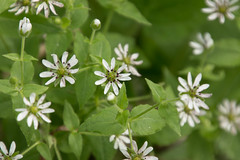
|
Caryophyllaceae Common chickweed Stellaria media Annual
* Similar to mouse-eared chickweed
|
|
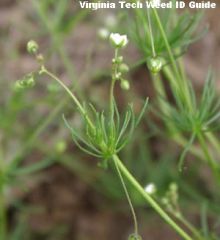
|
Caryophyllaceae Corn spurry Spergula arvensis Annual
* Distinctive foliage - fleshy, needle-like leaves, 20-50 cm long, attached to stem nodes in whorls of six to ten.
|
|
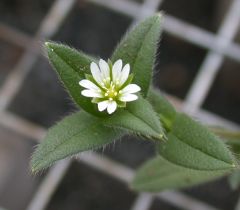
|
Caryophyllaceae Mouse-eared chickweed Cerastium vulgatum Perennial * Reproduces by seeds and spreads by rooting along its creeping stem * Similar to common chickweed, but much more hairy |
|
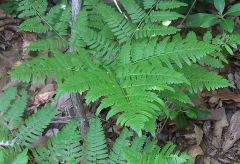
|
Dennstaedtiaceae Bracken fern Pteridium spp Perennial * Only fern we need to know * Extensive root system (rhizomes) * Attracted to thiomine deficient soil - good indicator |
|

|
Amaranthaceae Redroot pigweed Amaranthus retroflexus Annual
|
|

|
Chenopodiaceae Lambs-quarter Chenopodium album Annual
* Edible |
|
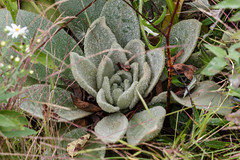
|
Scrophulariaceae Common mullein Verbascum thapsus Biennial / short-lived perennial
* Rosette leaves can be over a foot long and are densely covered on both sides with soft hairs. |
|
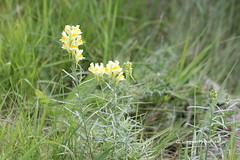
|
Scrophulariaceae Yellow toadflax Linaria vulgaris Perennial
* Stalkless leaves are narrow and pointed at both ends; bright yellow "snapdragon-like" flowers with an orange spot on the lower lip are 2 to 3.5 cm long
|
|

|
Rosaceae Himalayan blackberry Rubus armeniacus Perennial * Very aggressive * Edible fruits make it so people do not want to cut it down |
|
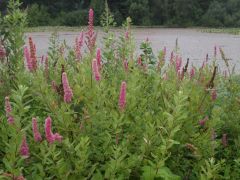
|
Rosaceae Hardhack Spiraea tomentosa Perennial * Simple alternate leaves, smooth-ish and dark green |
|
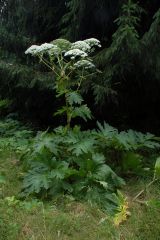
|
Apiaceae Giant hogweed Heracleum mantegazzianum Short-lived perennial
* Photophyllotoxins that can cause skin burns and blindness to eyes |
|
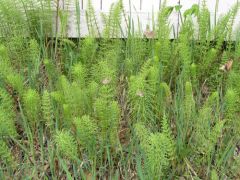
|
Equisetaceae Field horsetail Equisetum arvense Perennial * Good indicator of acidic soil * Whorled leaves |
|
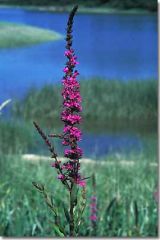
|
Lythraceae Purple loosestrife Lythrum salicaria Perennial
* It can be identified while in bloom by its purple-magenta flowers that form on distinctive terminal spikes. |
|
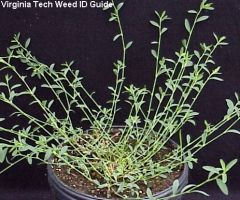
|
Polygonaceae Prostrate Knotweed Polygonum aviculare Short-lived perennial or annual * Contains numerous slender, wiry stems that are highly branched and form mats. The extensive branching gives it a zigzag appearance. * The inconspicuous flower heads are found at the top of short stalks that grow from the bases of leaves. * They consist of a cluster of two to eight tiny, green flowers with white or pink edges.
|
|
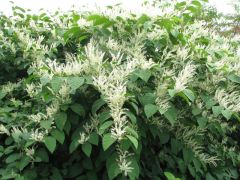
|
Polygonaceae Japanese knotweed Polygonum cuspidatum Perennial * Stems are round, reddish-purple, smooth and have a bamboo-like appearance. * Leaves are ovate with a flat base, reaching 3-6 inches long and 2-5 inches wide with pointed tips. * Flowers are greenish-white.
|
|
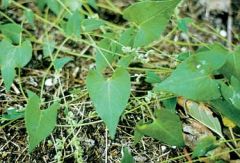
|
Polygonaceae Wild buckwheat Polygonum convolvulus Annual * Heart shaped leaves * Individual flowers are small greenish-white and not more than ¼ inch across * Similar to morning glory |
|
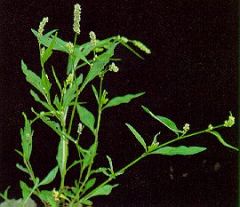
|
Polygonaceae Green smartweed Polygonum scabrum Annual |
|
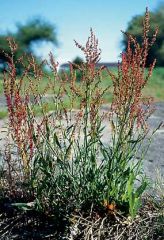
|
Polygonaceae Sheep sorrel Rumex acetosella Short-lived perennial
* Sheep Sorrel is a relatively unassuming plant, that grows from 4 to 18 inches in height.
|
|

|
Polygonaceae Broadleaf dock Rumex obtusifolius Perennial * Curly broad leafs |
|
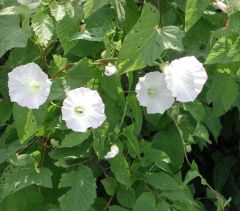
|
Convolvulaceae Hedge bindweed Convolvulus sepium Perennial * Similar to wild buckwheat * However, the hedge bindweed has large flowers unlike the wild buckwheat (also it is perennial vs. annual) * Medicinal uses - laxatives |
|
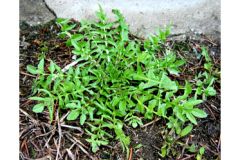
|
Brassicaceae Shepherd's purse Capsella bursa-pastoris Annual * Shepherd’s purse is in the mustard family but it is distinguishable by its valentine or purse-shaped seedpods. * In the rosette stage, it can be distinguished from other mustards with the lobed basal leaves as they are usually hairy, the lobes or divisions more or less uniform on each side, and its generally small size. * Edible
|
|

|
Brassicaceae Hoary allysum Berteroa incana Biennial / Short-lived perennial * Flowers: Rounded cluster 1 to 2 inches across at the end of branching stems near the top of the plant * Leaves are 1½ to 3 inches long, up to ½ inch wide, toothless, have a pointed or blunt tip and no leaf stem. They are covered in fine hairs that give them a grayish green color. |
|
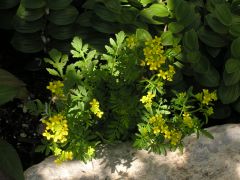
|
Brassicaceae Creeping yellow cress Rorippa sylvestris Perennial * Yellow flowers * Leaves are compound and alternate
|
|
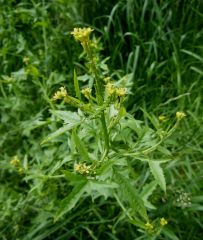
|
Brassicaceae Hedge mustard Sisymbrium officinale Annual * It is distinguished by the large terminal segment of the divided leaf, short tapering pods on very short stalks closely pressed to the stem, and the plant frequently having a gray-green appearance
|
|
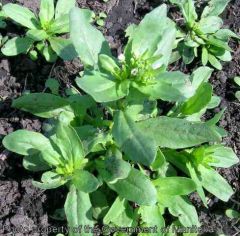
|
Brassicaceae Stinkweed Thlaspi arvense Annual * Lower parts of the weed are arranged in rosette * Nasty odour when crushed * Mature plant has long stalks with alternate leaves and white flowers |
|
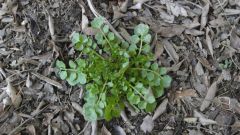
|
Brassicaceae Bittercress Cardamine spp Annual * Forms basal rosettes featuring stems that branch out from the soil line in a circular formation. * Bittercress produces lobed leaves and small, white, 4-petaled flowers. |
|

|
Brassicaceae Wild radish Raphanus raphanistrum Annual
|
|

|
Solanaceae Black nightshade Solanum nigrum Short-lived perennial * Medicinal uses - fever, laxative * Almost hairless and waxy stem |
|
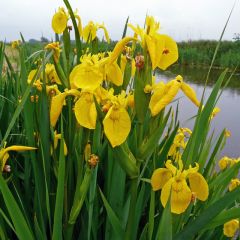
|
Iradaceae Yellow flag iris Iris pseudacorus Perennial * Flowers have three drooping, deep-yellow sepals with purple-brown markings that look like large petals, surrounding three smaller upright petals. * Grows near wetlands |
|
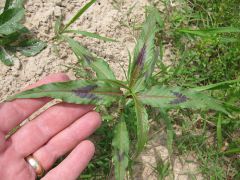
|
Polygonaceae Lady's thumb Polygonum persicaria Perennial * Pinkish-purple flowers * Easiest way to identify is the smudge marks on leaves |
|
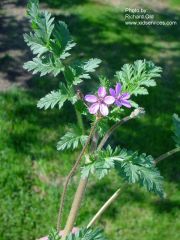
|
Geraniaceae Stork's bill Erodium cicutarium Annual * Hairy stems * Beautiful flowers |
|
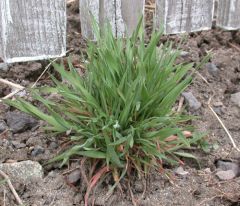
|
Poaceae Downy Brome Bromus tectorum Annual
|
|
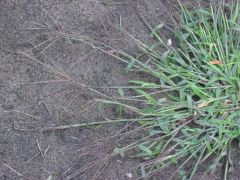
|
Poaceae Large crabgrass Digitaria sangulinalis Annual * Stems are flat in cross-section, often purplish, and usually branched at the base. Leaves are flat, rolled in the bud and have a prominent midvein. * It can be distinguished from smooth crabgrass, D. ischaemum, by its longer, narrower leaf, and presence of long stiff hairs on the sheath and on the upper and lower leaf surfaces
|
|
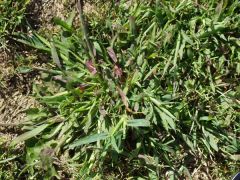
|
Poaceae Smooth crabgrass Digitaria ischaemum Annual
* Purple leaves and smooth stem* Similar influorescence to large crabgrass
|
|
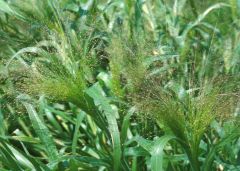
|
Poaceae Witchgrass Panicum capillare Annual * Hairy stems (red) * Witch's broom when fully matured
|
|
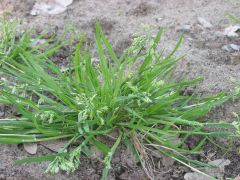
|
Poaceae Annual blue grass Poa annua Annual * One of the most common grass weeds * Has little white flowers |
|

|
Poaceae Green foxtail Setaria viridis Annual * Narrow leaves that look like spikes * Cylindrical seedheads |
|
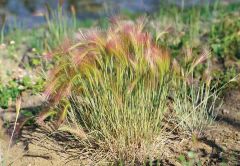
|
Poaceae Foxtail Barley Hordeum jubatum Perennial * Long spiny/spiky fluorescence |
|
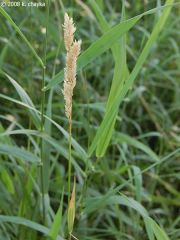
|
Poaceae Reed Canary Grass Phalaris arundinaceae Perennial * Persistent seed bank * Tall, 45 degree angle leaves |
|

|
Poaceae Barnyard Grass Echinochloa crus-galli Annual * Hairless and red-ish stems |
|
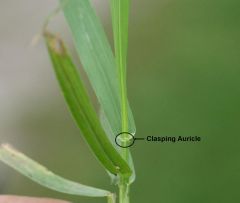
|
Poaceae Quackgrass Agropyron repens Perennial * Similar to crabgrass - leaves spiral at end * Has auricle that wraps around stem
|
|
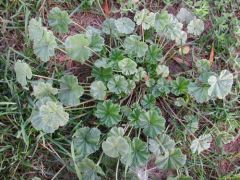
|
Malvacaeae Common Mallow Malva neglecta Annual * Kidney shaped leaves * Has lavender flowers with 5 petals |
|

|
Onagraceae Fireweed Epilobium angustifolium Perennial * Pretty easy to identify * Has medicinal uses (shoots can be eaten) |
|
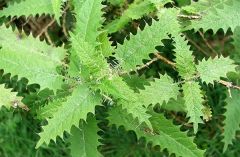
|
Urticaceae Stinging nettle Urtica dioica Perennial
* Stings you (hence the name)
|
|
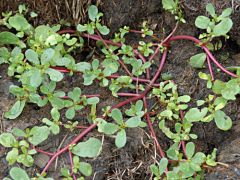
|
Portulacaceae Purslane Portulaca oleraceae Annual
* Crawling |
|
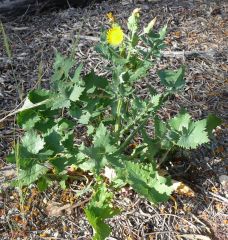
|
Asteraceae Annual sow-thistle Sonchus oleraceus Annual - large terminal lobes |
|
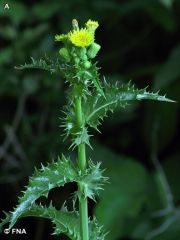
|
Astraceae Spiny annual sow-thistle Sonchus asper Annual - similar to annual sow thistle - leaves are prickly to the touch - waxier than annual sow thistle |
|
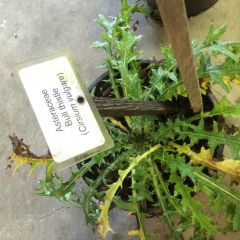
|
Asteraceae Bull thistle Circium vulgare Biennial - large flowers - similar to canada thistle - long spines coming off terminal leaves (main difference between canada thistle)
|
|
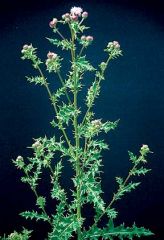
|
Asteraceae Canada thistle Circium arvense Perennial - looks similar to bull thistle |
|
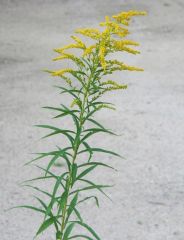
|
Asteraceae Canada goldenrod Solidago canadensis Perennial - narrow, alternate leaves which - causes hayfever - has yellow flowers |
|
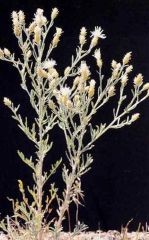
|
Asteraceae Diffuse knapweed Centaurea diffusa Biennial / short-lived perennial - hairy, alternate leaves - upright and branched stem
Spotted knapweed Centaurea maculosa Biennial / short-lived perennial - VERY similar except it has spots underneath the leaves |
|
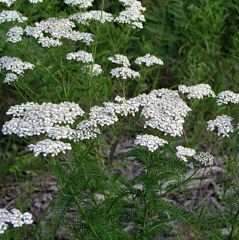
|
Asteraceae Yarrow Achillea millefolium Perennial - finely divided leaves / fern-like - leaves numerous at base but become fewer upwards the stem - umbel influorescense |
|
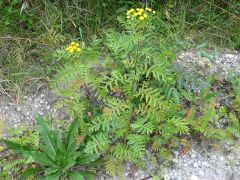
|
Asteraceae Common tansy Tanacetum vulgare Perennial - hairless upright stems - button shaped flowers (yellow) - fern-like leaves - soil indicator: nutrient deficiency |
|
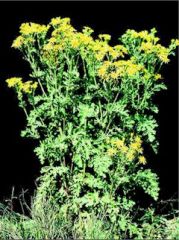
|
Astraceae Tansy Ragwort Senecio jacobaea Biennial / Short-lived perennial - similar to common tansy - ray flowers and deeply lobed leaves are the differences
|
|
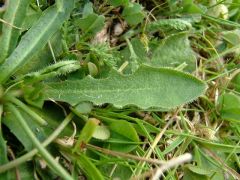
|
Asteraceae Spotted cat's ear Hypochaeris radicata Perennial - reproduces only by seeds - very similar to dandelion, except it has hairy leaves |
|
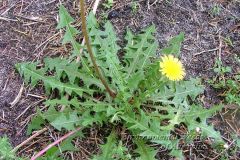
|
Asteraceae Taraxacum officinale Perennial - deeply lobed leaves and pointy - hairless - similar to spotted cat's ear |
|
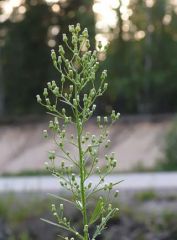
|
Asteraceae Canada Fleabane Conyza Canadensis Annual
|
|
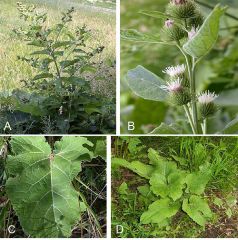
|
Astraceae Common Burdock Arctium minus Biennial - has cockleburs that stick to you |
|
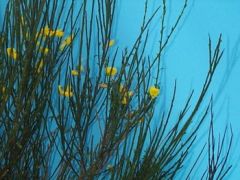
|
Fabaceae (Nitrogen fixer family) Scotch broom Cystisus scoparius Perennial - long lasting seed bed - fire hazard
|
|
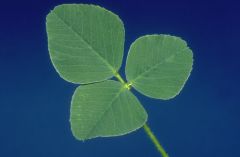
|
Fabaceae Black medick Medicago lupulina Annual - similar to clover leaves - difference: top leaf is bigger than the other leaves; not evenly distributed - has black seed pods
|
|
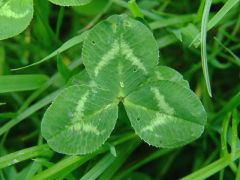
|
Fabaceae White clover Trifolium repens Perennial - evenly distributed leaves - white marks - oval shaped leaves
|
|
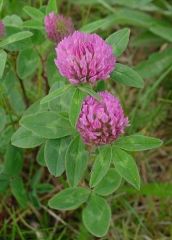
|
Fabaceae Red Clover Trifolium pretense Short-lived perennial - larger leaves than white clover - red flower |
|
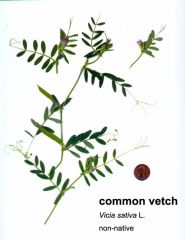
|
Fabaceae Vetch Vicia spp. Annual or Perennial |
|
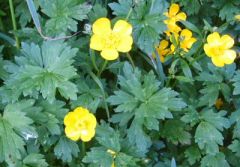
|
Ranunculaceae Creeping buttercup Ranunculus repens Perennial - reproduces by seed only - acidic soil indicator - very distinct leaves: similar to maple leaf |
|

|
Plantaginaceae Broad-leaved plantain Plantago major Perennial
|
|
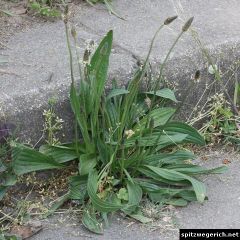
|
Plantaginaceae Narrow-leaved plantain Plantago lanceolata Perennial |
|
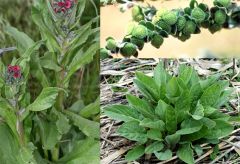
|
Boraginaceae Hound's tongue Cynoglossum officinale Biennial - Red/purple flowers - poisonous to livestock - sticky seeds |
|
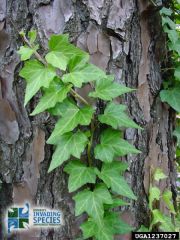
|
Araliaceae English Ivy Hedera helix Perennial - shiny leaves - can topple mature trees by wrapping around them |
|
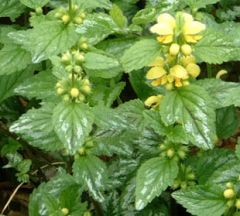
|
Lamiaceae (mint family) Yellow archangel (lamium) Lamium galeobdolon Perennial - opposite leaves & white mark - hairy and square stem - spreads by fragments or seed |
|
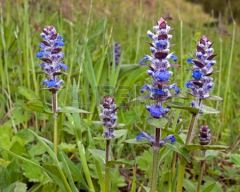
|
Lamiaceae Heal-all Prunella vulgaris Perennial - purple flowers arranged in a whorl - opposite leaves |
|
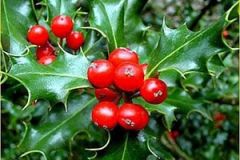
|
Aquifoliaceae English Holly Ilex aquifolium Perennial - commonly used as a christmas decoration - toxic berries - shiny and with sharp spines alternatively up and down - shallow rooted |
|
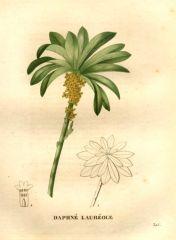
|
Thymelaeaceae Daphne laurel Daphne laureola Perennial - all parts are toxic - leaves form whorls at the top and shiny - tiny yellow flowers at base of leaves - has black berries that are poisonous |
|
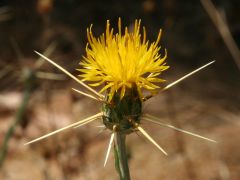
|
Early Detection Rapid Response Species Asteraceae Yellow star thistle Centaurea solstitialis Annual - very distinct spikes at the base of flowers - neurotoxin to horses |
|
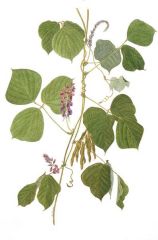
|
Fabaceae Kudzu Pueraria montana Perennial - 3 large leaflets per petiole - purple flowers |
|
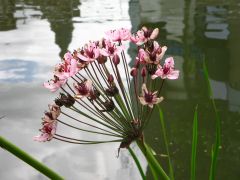
|
Butomaceae Flowering rush Butomus umbellatus Perennial - usually pink-white flowers - umbel influorescence - triangular cross section |

